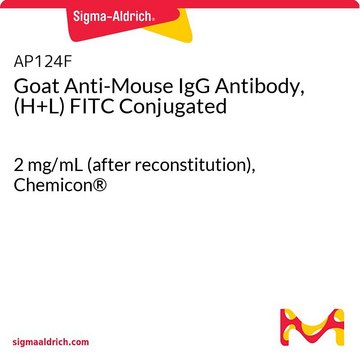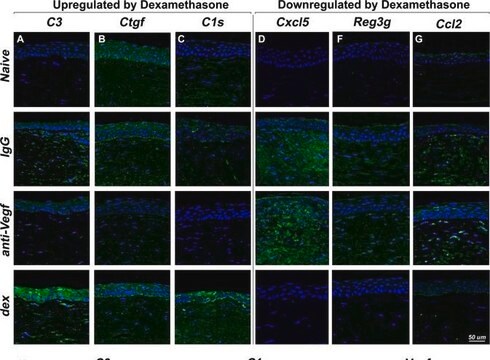AP308F
Goat Anti-Mouse IgG Antibody, (H+L) FITC conjugate
1.15 mg/mL, Chemicon®
Sign Into View Organizational & Contract Pricing
All Photos(1)
About This Item
UNSPSC Code:
12352203
eCl@ss:
32160702
NACRES:
NA.46
Recommended Products
biological source
goat
Quality Level
conjugate
FITC conjugate
antibody form
affinity purified immunoglobulin
antibody product type
secondary antibodies
clone
polyclonal
species reactivity
mouse
manufacturer/tradename
Chemicon®
concentration
1.15 mg/mL
technique(s)
immunofluorescence: suitable
shipped in
wet ice
target post-translational modification
unmodified
Related Categories
General description
Immunoglobulin G (IgG), is one of the most abundant proteins in human serum with normal levels between 8-17 mg/mL in adult blood. IgG is important for our defence against microorganisms and the molecules are produced by B lymphocytes as a part of our adaptive immune response. The IgG molecule has two separate functions; to bind to the pathogen that elicited the response and to recruit other cells and molecules to destroy the antigen. The variability of the IgG pool is generated by somatic recombination and the number of specificities in an individual at a given time point is estimated to be 1011 variants.
The reagent is an affinity purified antibody from goat. The purified antibody is conjugated to fluorescein and stabilized in buffer.
Specificity
Specific for mouse IgG, heavy and light chain. The cross-reactivities of anti-mouse IgG antibody are tested in an ELISA. Minimum cross-reactivity to human IgG.
Application
Detect Mouse IgG using this Goat anti-Mouse IgG Antibody, (H+L) FITC conjugate validated for use in IF.
F/P RATIO: 4-6
Immunohistochemistry: 1:200-1:500 (1-4)
Immunocytochemistry: 1:200-1:500 (1-4)
Flow Cytometry: 1 μg per 1x 10E6 cells (1,2,4) FITC absorption emission is 488-492nm, its emission peak is 520nm.
Optimal working dilutions must be determined by the end user.
Immunohistochemistry: 1:200-1:500 (1-4)
Immunocytochemistry: 1:200-1:500 (1-4)
Flow Cytometry: 1 μg per 1x 10E6 cells (1,2,4) FITC absorption emission is 488-492nm, its emission peak is 520nm.
Optimal working dilutions must be determined by the end user.
Research Category
Secondary & Control Antibodies
Secondary & Control Antibodies
Research Sub Category
Whole Immunoglobulin Secondary Antibodies
Whole Immunoglobulin Secondary Antibodies
Physical form
ImmunoAffinity Purified
Lyophilized. Buffer = 0.02M Phosphate Buffer, 0.25 M NaCl, pH 7.6 with 15 mg/mL BSA and 0.1% Sodium azide. Reconstitute with 1 mL of sterile distilled water.
Storage and Stability
Maintain lyophilized product at 2–8°C for up to 12 months after date of receipt. After reconstitution the product is stable for several weeks at 2–8°C as an undiluted liquid. For extended storage after reconstitution, add an equal volume of glycerol to make a final concentration of 50% glycerol followed by storage at -20°C in undiluted aliquots for up to 12 months. Please note the concentration of protein (and buffer salts) will decrease to one-half of the original after the addition of glycerol. Avoid repeated freeze/thaw cycles. Protect from light.
Legal Information
CHEMICON is a registered trademark of Merck KGaA, Darmstadt, Germany
Disclaimer
Unless otherwise stated in our catalog or other company documentation accompanying the product(s), our products are intended for research use only and are not to be used for any other purpose, which includes but is not limited to, unauthorized commercial uses, in vitro diagnostic uses, ex vivo or in vivo therapeutic uses or any type of consumption or application to humans or animals.
Not finding the right product?
Try our Product Selector Tool.
hcodes
pcodes
Hazard Classifications
Aquatic Chronic 3
Storage Class
11 - Combustible Solids
wgk_germany
WGK 3
Certificates of Analysis (COA)
Search for Certificates of Analysis (COA) by entering the products Lot/Batch Number. Lot and Batch Numbers can be found on a product’s label following the words ‘Lot’ or ‘Batch’.
Already Own This Product?
Find documentation for the products that you have recently purchased in the Document Library.
Placentation in Sigmodontinae: a rodent taxon native to South America.
Favaron, PO; Carter, AM; Ambrosio, CE; Morini, AC; Mess, AM; de Oliveira, MF; Miglino, MA
Reproductive Biology and Endocrinology null
Placentation and fetal membrane development in the South American coati, Nasua nasua (Mammalia, Carnivora, Procyonidae).
Favaron, PO; Morini, JC; Mess, AM; Miglino, MA; Ambrosio, CE
Reproductive Biology and Endocrinology null
Chorioallantoic placentation in Galea spixii (Rodentia, Caviomorpha, Caviidae).
Oliveira, MF; Mess, A; Ambrosio, CE; Dantas, CA; Favaron, PO; Miglino, MA
Reproductive Biology and Endocrinology null
Identification of mouse embryonic stem cell-associated proteins.
Hossein Baharvand,Ali Fathi,Hamid Gourabi,Sepideh Mollamohammadi,Ghasem Hosseini Salekdeh
Journal of Proteome Research null
Andrea M Mess et al.
Reproductive biology and endocrinology : RB&E, 10, 102-102 (2012-12-04)
Since Xenarthra are serious candidates for being basal to Eutheria, their characteristics, e.g. the placental system, influence perceptions of evolution. However, in the subgroup containing the anteaters, data are very limited. The present study aims to elucidate the nature of
Our team of scientists has experience in all areas of research including Life Science, Material Science, Chemical Synthesis, Chromatography, Analytical and many others.
Contact Technical Service








